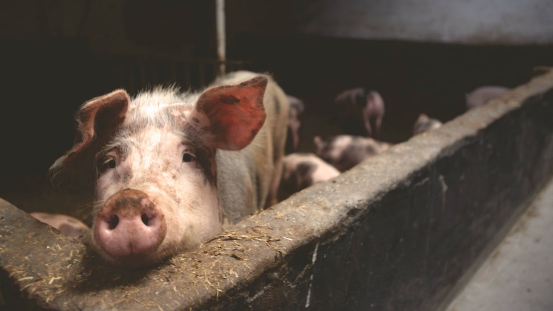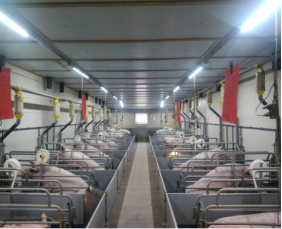The current pig industry faces the challenge of improving pig welfare and performance. The role of lighting technology has been largely overlooked, although the light is known to affect pigs' daily rhythms and productivity strongly. For example, pigs need suitable light levels to recognize each other, communicate, and view feeders. Pigs prefer to sleep in dim lights, suggesting that bright lights should not illuminate the lying area of the pig house.
Since lighting strongly influences pig welfare and performance, it is important to adopt optimal lighting technology solutions in a pig house. LED solutions offer the opportunity to simulate "natural light states," stimulate natural biological processes, and improve animal welfare in pig production.
On the other hand, knowing some related knowledge is vital when choosing lighting technology solutions for your indoor pig units. This article will focus on the impact of lighting technology on pig welfare and performance, and Hontech-wins pig lighting solutions.

Can Artificial Lighting Technology Improve Pig Welfare and Performance?
Although it is generally overlooked, lighting is an important part of pig management. For example, light can directly influence the pig’s biological clock, such as the biorhythm, social behavior, and overall activity. The right lighting technology solution depends on several factors, including spectrum, distribution, flicker, light intensity, and photoperiod.
For example, a light period of more than 16 hours increases feed intake, growth, and health of young and growing pigs compared to the 8 hours per day. On the other hand, light intensity and spectrum play an important role in pig welfare by affecting behavioral rhythms and emotional states.
Introduce to Various Aspects of Lighting Technology
Light Spectrum
The light spectrum is the visible part of the electromagnetic spectrum. Pigs have a visible spectral range of 380-694nm with peak wavelengths at 439nm (blue) and 556nm (green). On the other hand, there is a difference between spectral sensitivity based on cone sensitivity and spectral sensitivity based on behavioral responses. Therefore, when considering improving pig welfare and performance, it is best to look at spectral sensitivity based on behavioral responses. With the right light solution according to the pig's visible spectrum, the pig's vision will improve, resulting in better behavior, better use of the environment, and less stress.
Light Distribution
The light distribution shows how evenly the light is distributed in the pig house. When the light is evenly distributed, there are no highlights and shadows. Pigs displayed an aversion to highlights, shadows, blacked-out patterns, and white-painted patterns. For example, pigs may back away when shadows or bright spots fall on the sidewalk or fence. These behavioral responses are caused partly by their instincts and rearing environment. Therefore, lighting solutions must provide uniform light distribution to prevent highlights and shadows.
Light Flicker
Flicker is a rapid change in the light output of a lamp. This rapid change in light output can be perceived consciously and unconsciously. Pigs perceive light flickering similarly to humans, which means pigs will notice a similar level of flickering. In humans, flickering can cause headaches, eyestrain, and poor concentration. It could mean that the pig's health is also affected by the light flicker. Therefore, a 100% flicker-free lighting solution is strongly recommended for pig houses.
Light Intensity
Light Intensity represents the brightness of light, measured in lux. Several studies have been conducted on the light intensity at different life stages to understand that pigs exhibit specific light intensity preferences. However, according to the current study results, there is no clear answer. But it is confirmed that fertility, growth, etc. can be improved by using the correct light intensity.
Photoperiod
The photoperiod represents the number of light hours in a day, which is the number of hours the lights are on in the pig house. Long photoperiods have a positive effect on production results. On the other hand, to optimize performance, it is important to provide the correct photoperiod at each stage of the pig's life. Correct photoperiod in each stage has several advantages, such as better feed conversion.
Hontech-wins Pig Lighting Technology

For pigs, optimal lighting optimizes their line of sight, increases welfare and performance, and meets their needs at different stages of the production cycle. We have introduced Pig Lighting Solutions with high-quality LED lights to improve pig performance significantly. The lighting solution includes two types of LED lights: T12 LED Pig Farm Lighting and T8 Pig Farm Lighting. Both products feature a cable design for series connection, optimal light distribution, and long life of over 50,000 hours. In addition, with an IP67 water resistance rating, the lighting remains resistant to high-pressure water jets, ammonia, and other cleaning chemicals.
Why choose Hontech-wins As Your Supplier
Hontech-wins LED poultry lighting system makes poultry life better. As a LED lamp supplier and dimmer manufacturer, we have strong hardware and software R&D capabilities. Hontech-wins team of engineers with 16 years of experience provides solutions to meet any need and requirement.
In addition, the company provides professional technical support for customer projects. For example, Hontech-wins advises and supports customers throughout the process of purchasing a poultry lighting system.
Hontech-wins products are exported overseas, boosting the development of the poultry field with high-quality products, and winning the market shares with excellent R&D strength. Contact us to boost your business.
Copyright ©2005-2013 Shenzhen Hontech-Wins Electronics Co., Ltd ICP 160086155 Technical Support Privacy Policy